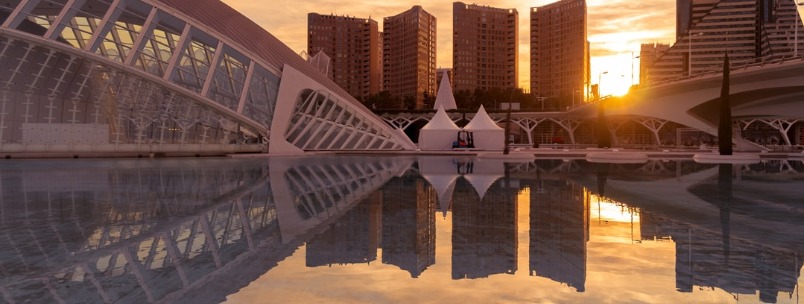Travel to Valencia Spain
Valencia is one of the most beautiful and historic cities of the world, it is located in the Mediterranean coast of the Iberian Peninsula on the shores Turia River in the Autonomous Community of Valencia, Spain. It is considered the third most important city in Spain and the third-largest city in Spain.
Valencia is a city full of traditions and festivities. Among these festivities, the most important is the local festivity of the Falles or Las Fallas, well-known worldwide. Among the traditions, the most important is the Water Court or El Tribunal de las Aguas declared Intangible Cultural Heritage of Humanity and the traditional Valencian dish is Paella, originated in the Valencia Community.
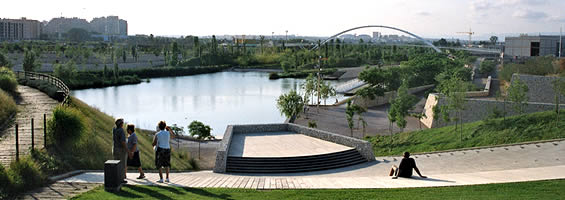
The city has a very rich history, which is impressed in the beautiful and extended historic center. Its historical and monumental heritage and the diverse scenic and cultural sites make of the city a great tourist international destination. The most representative Valencian monuments are The Miguelete, the Cathedral, the Serrano’s and Quart’s Towers, the Lonja de la Seda, and The city of Arts and Sciences. Some of these monuments were declared World Heritage by UNESCO in 1996.
Valencia is also full of museums, among the most representatives we must mention: The Museum of Fine Arts in Valencia, City of Arts and Sciences, Prehistory Museum of Valencia, The cathedral museum, Institute of Modern Art of Valencia.
Besides the archeological monuments, Valencia is known as the city of the flowers, it counts with many beautiful landscapes, gardens, and parks such as the Turia garden, The Botanic Garden, The Royal Gardens, and The Ayora Garden among others.
Nowadays, Valencia has grown rapidly becoming an economic and financial leader in Spain; this progress is the result of the tourism and the construction industry. One of these constructions was the city of Arts and Sciences that was designed by Santiago Calatrava and Félix Candela and constructed by the engineers Alberto Domingo y Carlos Lázaro; it attracts more than 4 million people each year.
Come and visit Valencia, enjoy all the beautiful landscapes, get involved with all the history and visit the entire historical and monumental heritage, the museums, the squares, etc. Valencia has great weather almost all year which invites you to enjoy all the traditional festivities and festivals.
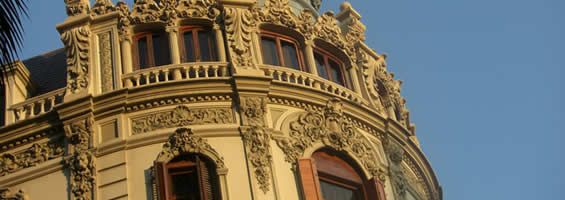
Getting around Valencia
Valencia is a perfect city for a tourist, it’s not big neither small. Most of their narrow streets are definitively best explored on foot and almost all of their main sights are easily reachable by walking because they are near one to each other. However, it is a good idea to take a bus to go to those places which are a little bit further like “The City of Arts and Sciences” or the “Llac Albufera”, fortunately, it has a very efficient, cheap and easy-to-use transport public service.
As an option, it is possible to buy a city transit pass which is valid for about three days that allows you to use boundlessly buses, trams, and the subway system and additionally offers discounts for some selected attractions. It is also available a very useful tourist information office which is always willing to answer any of your doubts. People who drive the taxis in Valencia are friendly and respectful, they will help you if you are having problems to communicate what you want, they are always willing to give you a piece of advice about the city or give you a free map.
Valencia owns a valuable history, therefore, possess lots of glorious attractions such as buildings, monuments, art sculptures, museums, and other beautiful places. It homes art and science but on the other hand offers very lively nightlife, lots of restaurants, bars and of course fascinating beaches.
This city has attractions everywhere, so, if you go to Valencia you can visit:
- The Ceramic Museum and enjoy its ceramic collection,
- The Botanical Garden, located near to the streets of the town center.
- The blue-domed Fine Arts Museum which preserves paintings by Velázquez and El Greco.
- The IVAM, a contemporary art museum.
- Sagunto, which is located in the north part, it is a famous place, known by its rich historical heritage. It’s major economic and tourism activity is the production of citrus fruits; if you go there you must visit its Castle and the Roman Theatre.
- Gandía, which is known for its beaches, It is a recently restored city, that constitutes a perfect place to walk, many of its streets are pedestrians If you go there, you must visit the “Colegiata” or “Seu”, the first church that was built in the city.
- La Albufera, this place is a sweet water lagoon which constitutes an important nature preserve for animal and plants.
- The Carmen Quarter, it is the bohemian quarter in the city, the ideal place to go dancing and have fun at night, it offers all kinds of bars and restaurants.
- Valencia Cathedral, an amazing building in the Old quarter of the city.
- Nova Tabarca, an island that features the historical remnants of past times, such as an eighteenth-century fortress
- La Lonja, which homes several Valencian famous attractions, such as the “Palacio de la Generalidad”, “Palace of the Marquis de Dos Aguas”, “the Plaza de Manises” and the “Campanil de la Iglesia de Santa Catalina bell-tower”.

Things to do in Valencia
Valencia offers to visitors lots of things to do; you’ll find different kinds of activities from cultural to funny and relaxing activities for all ages and budgets. The city houses several places such as beaches, historical and cultural places, art galleries and museums an also areas in which you can take a rest. It’ll depend on the season that you are planning to visit Valencia for example during spring or fall you’ll find most activities to enjoy the trip even more because in these months the weather allows taking a good sun-bath, hiking, and do all kinds of outdoors activities.
We recommend a list of interesting things you can do when you’ll go to Valencia, those are detailed below:
Visit The Cathedral in Valencia Spain
The Metropolitan Cathedral-Basilica of the Assumption of Our Lady of Valencia or Saint Mary’s Cathedral is a Roman Catholic church is a place that every visitor to Valencia must know. The cathedral is mainly a Gothic building and although the several restorations, it is in a good state of preservation. It’s the mother Church of the Christian community in Valencia and although it’s not a museum there are many interesting things to contemplate such as: 15th-century paintings and other artworks; you can also enjoy a panoramic view of the city in all direction from the bell tower of the cathedral.
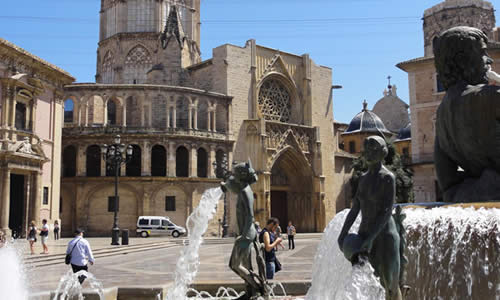
Visit The City of Arts and Sciences
The City of Arts and Sciences is surely one of the main attractions of the city for locals and foreign people. It’s a huge complex as its name suggests it’s like a town so it’ll take you much more than two hours to take a look at the place in which technology, architecture, cosmology, arts, music, math, education and all the science, in general, are gathered together in harmony.
The City of Arts and Sciences has fabulous futuristic architecture and its outdoor areas are landscaped with waterfalls and gardens distributed carefully.

Visit their Public gardens
Valencia boasts many public gardens in which you can enjoy peaceful walking paths, water fountains and even monuments; those public places will allow you to relax some time during your trip and maybe you’ll find playgrounds for your kids. The Botanical Gardens is the oldest garden in Valencia (since 1802) with more than 3000 different species of plants. The modern gardens: Monforte Gardens are from 19th century and features marble statues, pools, fountains and beautiful landscapes effects; Jardines de los Reales Viveros (Royal Nursery Gardens), Jardines del Viejo Cauce del Turia (Gardens of the Old Course of the River Turia) and more are other Gardens in Valencia.
Visit their Beaches
Valencia community has some of the best beaches in Spain; although most of them aren’t really walking distance from the city, we guarantee that it’ll worth the travel by bus to a really good beach. Some of the most popular beaches in Valencia are: La Malvarrosa beach, an urban beach with fine and golden sand and facilities for disabled people; Cabañal- Arenas features besides the sand, beautiful amusement areas for children; Pinedo Beach is an open beach with a great environment; El Saler beach is the nearest good beach to Valencia with 6 kilometers of sandy beach and it’s widely known as a great quality beach. Other Beaches are: Davesa Beach, Perellonet Beach, L’Ahuir Beach, Miramar Beach, Norte de Gandia / Gandia Beach, Rafalcaid Beach and El Racó.
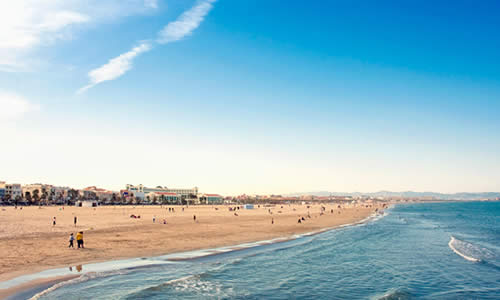
Enjoy the Valencia nightlife
Valencia nightlife is one of the things to do in Valencia you cannot miss; although it’s not well-known among tourists, Valencia has several places to enjoy each night of your stay in Valencia. The historic Barrio Carmen is the best area where one can experience parties in Valencia; you’ll find discotheques, bohemian bars, clubs, and more. Other key areas of nightlife in Valencia are: Canovas, Aragon, Malvarrosa and Heron City.
Other attractions
- Serrano Towers: These 15th-century towers were once part of the old city walls, and now they are considered to be the largest Gothic city gateway in Europe.
- Plaza del Mercado: The Plaza del Mercado is a well-known destination due to the interesting buildings located there: The Silk Market that is Patrimony of Humanity, The Santos Juanes Church and The Central Market.
- La Tomatina: You can enjoy this festival in the Valencian town of Buñol; it consists in throwing tomatoes at each other participant.
- Bullfight in the Plaza de Toros: The Plaza de Toros de Valencia is a bullring used for some of the most important bullfights.
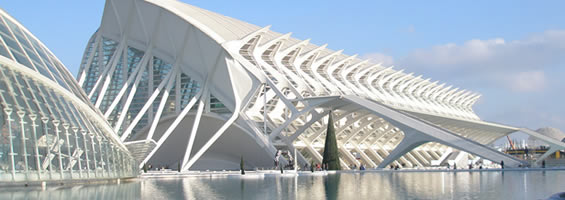
Parks and Gardens in Valencia
Valencia is a city that can boast of its numerous parks and gardens. These extensive greenbelts in addition to embellish the cityscape, they have become a point of meeting and spreading to all people. The large variety of plants and vegetables joined to a long floral tradition explains why Valencia is known as “The city of flowers and light”.
Aquópolis
Aquópolis is an aquatic park located in Valencia, its antique name was Acuasol, in spite of this name change the entertainments it offers are the same. Among these attractions we can mention their water chutes, the Kamikaces “Himalaya”, the Black Hole, the “Perezosos”, the Niagara river in which can go over the swimming pools aboard a floater, the waves swimming pool, etc.
Cabecera Park
It was inaugurated in the 2004 year, it is located in the end of Turia river. The principal attraction is an enormous artificial lake located in the central part because all the other attractions are around it. It also has an open auditorium, paths, and lanes to run or to go in bicycle, a jetty, a bar, an infantile game zone, artificial mountains, and the “Molí del Sol”. It is the ideal place to pass the Sunday with your family, practice sports, give a walk or take your children to play.
The western Park
The park is located in the Cid Avenue, it was made in the plot of land of the quarters of the Air Force, for this reason it was built the cabecera monument. Inaugurated in 1995, and it has an auditorium for concerts, ice rinks, and another spreading facility.
Orriols park
It was inaugurated on September 2000, it is located in a new zone of Orriols’s neighborhood, it intends to give to this neighborhood a spreading and recreation zone and at the same time to oxygenate a place of recent urban expansion, where live many young couples with little children. It possesses sports facilities to practice swimming, basketball, fields to play soccer, tennis courts and infantile games; it also has a garden with many trees and plants.
Botanical Garden
It is one of the biggest gardens in Europe, was founded in the year 1567 for studying medicinal plants. It is a lush place full of plants; there are hundreds of species and varieties of trees, really big trees, shrubs, palms, etc.
Turia River Gardens
The antique bed of Turia River is at the present time one of the principal recreational urban zones of Valencia. It is an extensive and original garden that has become the biggest green lung of the city. Due to its extension, it is divided in several sections: the stretch I, the stretch II, stretches IV – V and the Gulliver’s park. Into these sections can be found wide grasslands and big trees in which you can take a rest; In general, these zones are well equipped with numerous benches, wastepaper baskets, drinkable- water sources, zones for the pets and according to the stretch, bars, sports infrastructures and infantile games.
Jardines de Real (Viveros) – Park / Garden in Valencia
“Los Jardines del Real” are also known as “Los Jardines de Viveros”. It is a beautiful and extensive garden that lodges a great variety of vegetable species; it is frequented by Valencian people as well as tourists.
It recreates different environments and it is accompanied by numerous sculptures, water fountains, ponds and diverse facilities such as an adventure playground or the zoo in which felines, bovines, equines, monkeys and other species are contemplated, it also lodges the Natural sciences museum.
“Los Jardines del Real” comprises diverse zones, such as “La Rosaleda”, which is an ample circular space in which grow hundred of multicolored roses, the great cage of birds, the pond or the children’s park, among others.
La Glorieta
This is the oldest garden in Valencia; the garden features famous statues, sculpted fountains and regional plants. It is the perfect place to stay for a while and read a good book on a bench.
Jardines de Monforte
It is considered one of the most beautiful in Spain and they form part of the national artistic treasure they are located in “La Plaza of the Legion Española”, near to “La Alameda” and “Los Jardines del Real”. In spite of being located in one of the highest circulated zones is famous by its tranquility and quietness. It has a neoclassical style but also possesses romantic aspects; its landscape is adorned by beautiful Italian sculptures, ponds, etc.
El Paseo de la Alameda
“El Paseo de la Alameda” includes about one kilometer along the bridges “Real” and “Aragón”. It is a place which is full of beautiful trees, most of them large-sized, antique and very robust. The antique style of the garden is kept by two towers dedicated to St. Felipe and San Jaime.
Nightlife in Valencia
Valencia Nightlife is part of Spain nightlife that boasts some of the most popular cities when it comes about nightlife, cities such as Madrid and Barcelona are widely known for their celebrations and parties; although Valencia nightlife it’s not popular as those cities, nightlife in Valencia is a party that seems to go on forever, especially in weekends that locals call La Movida.
La Movida
La Movida in Valencia is a phenomenon among youth; all young people go to discotheques, bars, and pubs, which boast a nice environment. You’ll find many people dancing, drinking and having fun in every street and beaches across the city
You’ll find different discotheques, bars and clubs scattered in the city center; and other popular areas to spend all week long, of course, you’ll find many establishments crowded especially in Saturdays and Fridays although most of them don’t start filling up until midnight.
Barrio del Carmen
One of the most popular places in Valencia is Barrio del Carmen (The Carmen Quartier); this historical neighborhood is full of restaurants to suit all tastes, bars, nightclubs and more. Many people enjoy dancing cobbled streets from one bar to the next. This part of Valencia is considered as the bohemian quarter with a mixture of art, decadence, and hedonism.
History of Valencia
The foundation of Valencia is often attributed to Junio Bruto by the year 137 B.C., later, the city was devastated by Pompeyo due to his fights against Sertorio; Valence and Sagunto, both constituted an important nucleus of the edetana region during the I century. At the beginning of the VII century, the Goth king Sisebuto expulsed the Byzantine people from Valencia and incorporated the city to the Goth monarchy, this way Valencia became an Episcopal see.
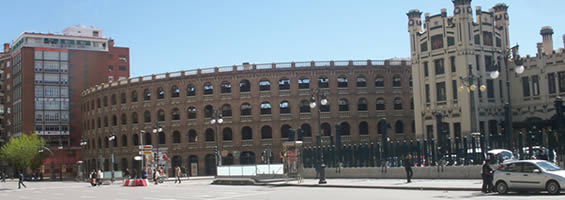
It was conquered by the Moslem people in 714 and was converted in cora capital and a vali seat. In the XI century, after the disintegration of the caliph of Cordova, Valencia was converted in the capital of the taifa kingdom. In 1238, the Ruzafa capitulation in front of Jaime I inaugurated the Christian kingdom in Valencia, this fact ended the five centuries of Moslem domination that had left in this town a deep cultural, artistic and also economic footprint.
In 1261 the king swore the Valencian kingdom jurisdictions and customs; they were conserved until the Nueva Planta decree in which was abolished in the year 1716. In the century XIV the union war exploded, this war last seven years and confronted Valencia against Pedro “the ceremonious” and finished when he won in Mislata. At the end of the XIV century, the confrontation between Fernando de Antequera and the Urgel’s earl caused a violent rivalry between the Centelles and the Vilaragut. In 1502 Fernando el Católico inaugurated the university, and later, between 1519 and 1522, exploded in Valencia the guild rebellion (Germanía’s rebellion).
In 1609 was produced the Moorish expulsion, it had serious consequences for the Valencian economy because in 1613 the Taula de Canvis was going down. During the Independence War, the Suchet marshal occupied the city (1812), but in 1813 the Elio general reconquered Valencia.
During the XIX century second half, Valencia became in one of the biggest rooting center of the republican and socialists ideals being the seat of the meetings of the Regional Spain Federation in 1871, 1883 and 1888; it was also the seat of the republican uprising in 1869 and seat of the proclamation of the Cantón de Valencia in 1873. During the civil war it became the republic capital after government flight (1937 – 1939), since 1982 is the capital of the Valencian community.
